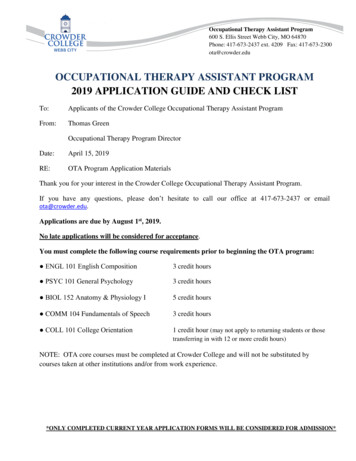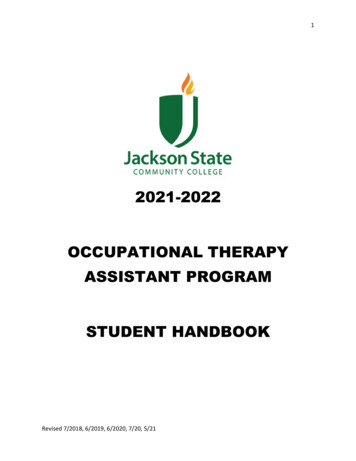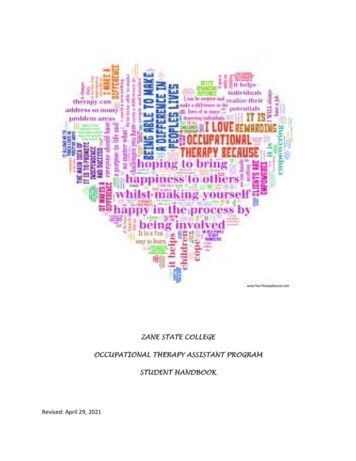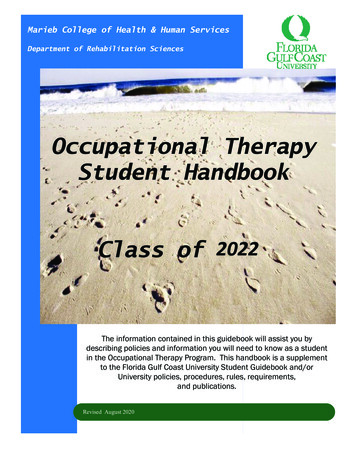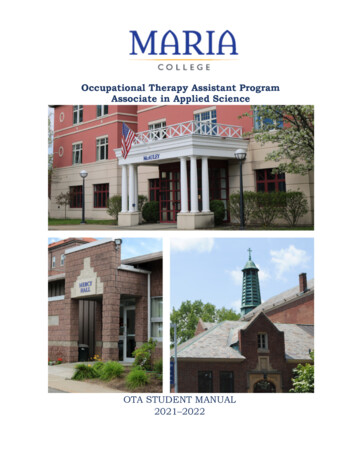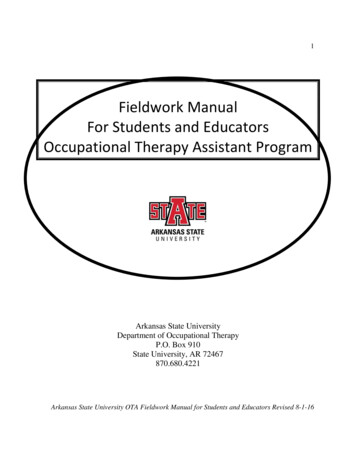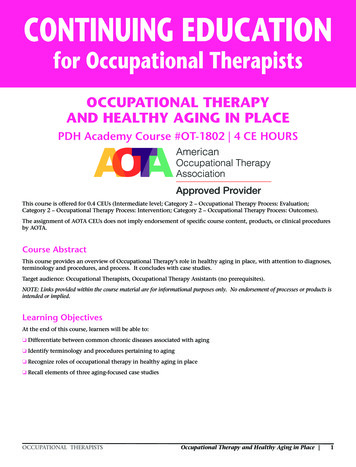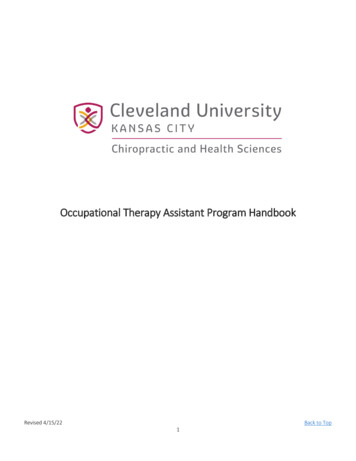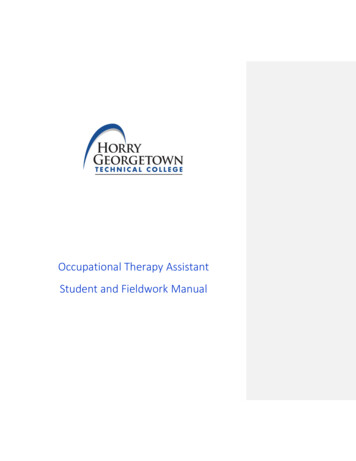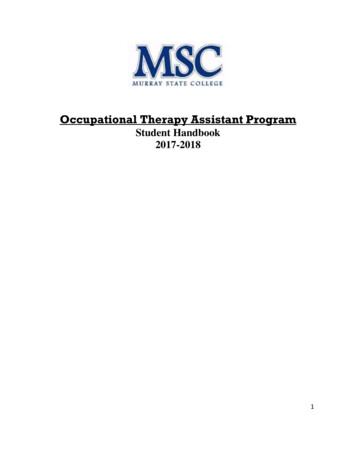
Transcription
OCCUPATIONAL THERAPY ASSISTANTPROGRAM HANDBOOKSUPPLEMENT TO THENORTHLAND COMMUNITY AND TECHNICALCOLLEGESTUDENT HANDBOOKCassie Hilts, Program DirectorGeralyn Peterson, Fieldwork CoordinatorTaylor Beatty, Clinical Lab Assistant2020January, 2020Occupational Therapy Assistant Program HandbookPage 1
Table of ContentsDescription of Program3Mission Statement3Philosophy Statement4Curriculum Design8Certification and credentialing requirements12Student Learner Outcomes12Program Plan13Prerequisites14Fieldwork16Course Descriptions17Admission Procedures21Eligibility for Advancement21Graduation Requirements22Program Standards22Probation and Dismissal23Advising related to coursework23Class Policy24Attendance Policy24Grievance Policy25Program Policies26Emergency, Evacuation, and college closures26Technical Standards27Student Outcomes30Student Statement of Understanding32NORTHLAND COMMUNITY AND TECHNICAL COLLEGEOccupational Therapy Assistant Program HandbookPage 2
OCCUPATIONAL THERAPY ASSISTANT PROGRAMEAST GRAND FORKSDESCRIPTIONThe Occupational Therapy Assistant Program is a two-year Associate Degree major designed toprepare students to locate employment as an Occupational Therapy Assistant.Occupational Therapy is the use of purposeful and meaningful activity with individuals who arelimited by physical injury or illness, psychosocial, developmental or learning disabilities, povertyand cultural differences or the aging process in order to maximize independence, preventdysfunction, and maintain health. The practice encompasses evaluation, treatment, andconsultation. Specific OT services include: teaching daily living skills; developing perceptual-motorskills and sensory integrative functioning; developing play skills and prevocational and leisurecapacities; designing, fabricating, or applying selected orthotic and prosthetic devices or selectiveadaptive equipment; using specifically designed crafts and exercises to enhance functionalperformance; administering and interpreting tests such as manual muscle or range of motion tests;and adapting environments for the handicapped. These services are provided individually, ingroups, or through social systems.Career opportunities include: Acute and long term care facilities, schools, community agenciesand activity directors. At the present time there is a need for OT personnel in rural settings. Thismajor also promotes the idea of professionalism and continuing education among OTA's so thatthey are made aware of their personal influence and responsibility in the health care field.This major includes general education and technical education courses leading to an Associate ofApplied Science degree. The curriculum includes basic human sciences, the human developmentprocess, specific life tasks and activities, understanding health and illness, and occupationaltherapy theory and practice. The major includes supervised fieldwork experiences. The Level IIfieldwork experience must be completed within 18 months of completion of OTA courses .ACCREDITATIONThe associate-degree-level occupational therapy assistant program is accredited by theAccreditation Council for Occupational Therapy Education (ACOTE) of the AmericanOccupational Therapy Association (AOTA), located at 6116 Executive Boulevard, Suite 200,North Bethesda, MD 20852-4929. ACOTE’s telephone number c/o AOTA is (301) 652-AOTA andits Web address is www.acoteonline.org. Graduates of the program will be eligible to sit for thenational certification examination for the occupational therapy assistant administered by theNational Board for Certification in Occupational Therapy (NBCOT). After successful completion ofthis exam, the individual will be a Certified Occupational Therapy Assistant (COTA). In addition,all states require licensure in order to practice; however, state licenses are usually based on theresults of the NBCOT Certification Examination. Note that a felony conviction may affect agraduate’s ability to sit for the NBCOT certification examination or attain state licensure.MISSION STATEMENTNorthland Community and Technical College Occupational Therapy Assistant Program(Northland OTA) supports the Mission of Northland Community and Technical College(Northland) through innovative leadership in OTA education, and provision of a quality learningenvironment that prepares learners with work and life skills to graduate as competent entry levelOccupational Therapy Assistants.VISION STATEMENTOccupational Therapy Assistant Program HandbookPage 3
The Occupational Therapy Assistant program will be highly valued for providingexceptional occupational therapy education to learners in partnership with localand regional healthcare facilities.PHILOSOPHY APPLIED TO INSTRUCTION AND LEARNING IN THE OCCUPATIONALTHERAPY ASSISTANT PROGRAMThe Northland Community and Technical College (Northland) Occupational Therapy Assistant(OTA) program’s Philosophy of education is consistent with the American Occupational TherapyAssociation (AOTA) philosophy statement, mission statement of Northland Community andTechnical College (NORTHLAND, 2003), the mission and philosophy statements of theNORTHLAND OTA program, the Occupational Adaptation frame of reference developed byJanette Schkade and Sally Schultz (1992) and Learning Styles by Pashler, McDaniel, Rohrer, &Bjork (2008).The philosophy of the program is designed to support the NORTHLAND Mission, NORTHLANDOTA mission, and AOTA’s Philosophy of Occupational Therapy Education.NORTHLAND Mission is “Northland Community and Technical College is dedicated to creating aquality learning environment for all learners through partnerships with students, communities,businesses, and other educational institutions”.NORTHLAND OTA’s Mission is “NORTHLAND OTA Program supports the Mission ofNORTHLAND of providing a quality learning environment through inter and intra professionalcollaboration to graduate competent entry level OTA s serving regional communities and beyond.The graduates will be lifelong learners, and display values and principles that reflect the AOTAprofessional standards and ethics.”AOTA’s Philosophy of Occupational Therapy Education“Occupational therapy education is grounded in the belief that humans are complex beingsengaged in a dynamic process of interaction with the physical, social, temporal, cultural,psychological, spiritual, and virtual environments. Through active engagement within the internaland external environments, humans evolve, change, and adapt. Occupational therapy educatorsadvocate the use of occupation to facilitate health promoting growth, change, and/or adaptationwith the goal of participation in meaningful occupation that supports survival, self-actualization,occupational balance, and quality of life. The profession of occupational therapy is unique anddynamic, grounded in core principles of occupation, and is influenced by emerging knowledgeand technologies. Thus, the education of future occupational therapists and occupational therapyassistants must consistently reinforce the development of new knowledge supporting the use ofoccupation, the application of clinical reasoning based on evidence, the necessity for lifelonglearning, and the improvement of professional knowledge and skills.Occupational therapy education promotes competence through educational experiences thatfoster the occupational therapists’ and occupational therapy assistants’ practice potential andscholarship development. Occupational therapy educators use active learning that engages thelearner in a collaborative process that builds on prior knowledge and experience and integratesprofessional academic knowledge, experiential learning, clinical reasoning, and self-reflection.Occupational therapy education promotes integration of philosophical and theoretical knowledge,values, beliefs, ethics, and technical skills for broad application to practice in order to improvehuman participation and quality of life for those individuals with and without impairments andlimitations.The occupational therapy education process emphasizes continuing critical inquiry in order thatoccupational therapists and occupational therapy assistants be well prepared to function andOccupational Therapy Assistant Program HandbookPage 4
thrive in the dynamic environments of a diverse and multicultural society, using the power ofoccupation as the primary method of evaluation, intervention and health promotion.”The Occupational Adaptation model discusses the influence of intrinsic motivation and the use ofeveryday life activities (occupations) on adaptation and human development. It statesoccupational therapy is based on the belief that occupation, including its interpersonal andenvironmental components may be used to prevent and mediate dysfunction, and to elicitmaximum adaptation.NORTHLAND OTA Program Education Philosophy:View of HumanityHumans have an innate drive to achieve mastery. The desire to achieve mastery together withthe environments demand for mastery results in various occupational challenges that areencountered throughout the lifetime. Individuals, as they encounter these challenges, respond ina manner that leads to adaptation. The adaptation process is influenced by the feedbackindividuals receive from the environment. When the feedback is integrated and the individualresponds to occupational challenges in a way that meets environmental demands, they achieverelative mastery and learning has taken place.View of the LearnerStudents come with a desire to learn. We believe that they should be provided occupationalchallenges based on the demands of the environment. We believe that students learn and retaininformation best when these challenges are taught in the context in which it will be implemented.The student should be allowed to practice the acquired skills and knowledge through producingresponses to the challenges. We believe that students should receive feedback from theenvironment regarding their responses to the occupational challenges. They need to be given anopportunity to reflect on the feedback and integrate that feedback prior to producing their finalresponses.We believe that students have a desire to learn and come with a variety of learning experiencesand expertise. We have a full range of students from recent high school graduates to adults whoare deciding to pursue a different career path in later adulthood. Thus, students enter theprogram with a variety of experiences, but they are novices when it comes to the occupationalchallenge and readiness skills. They use their life experiences to bridge this gap.We believe that students of all ages are capable of taking responsibility for their ownlearning. Learners should be taught how to think, not what to think. Learners should be able tomake their own decisions and modify their approach based on the context of the situation throughpractical application of problem-solving skills. We believe that students learn best by criticallythinking about the problem, analyzing the sequence of the problem and desired outcome, andlearn through doing the task and subsequent feedback.We believe students should initiate the learning process through asking questions, discussingpast experiences with other students to inform new learning within the classroom setting, andutilize technology to assist them in seeking knowledge to unanswered questions. We believe thatstudents are motivated to learn when the topic/and or concept can be readily applied to the “realworld” context. Interests are piqued when students are able to relate it to an aspect of their livesand can freely interact and discuss this fact with others. We believe that students learn best fromeach other and when the instructor serves as a facilitator and guide, rather than an instructor thatdirects and controls the learning process.We believe that group tasks, group discussion, investigative and discovery learning coupled withan integrated curriculum and cooperative learning are the best approaches for lifelong learning. The role of the faculty would be that of an organizer and facilitator, guiding thelearning process and providing feedback to the learner to assist the learner in modifying theirapproach for a successful learning outcome. Activities that incorporate the visual, kinesthetic,and affective learning styles of the student tend to be more powerful methods ofOccupational Therapy Assistant Program HandbookPage 5
teaching. Methods such as role-play, simulation, and experiential learning assist the learner inthe ability to integrate concepts learned in the classroom to useful skills needed to solve problemsin context. The connection of mind, body and spirit during this process occurs through analysis,synthesis and evaluation of the individual’s learning.We believe that each student is unique and has their own preferred style of learning. We feel it iscritical to include a variety of teaching methods that can appeal to a wide variety of learning stylesthat the students bring. We believe that content should dictate the kind of learning activities thatare offered.Pashler, et. al. (2008) research indicates that the type of teaching styles used should be based onthe content that is being taught and that a variety of instruction methods benefits all students.There are several different models or ways to describe learning styles. One model identifies threedifferent learning styles (VAK): Visual Learners, Auditory Learners, and Kinesthetic Learners(Clark, 2011). Sharon Bowman (1998), describes four learning styles. They include: LearningStyle One: Peacemaker; Learning Style Two: Truth Keeper; Learning Style Three: SolutionSeeker, and Learning Style Four: Risk Taker (Bowman, 1998). Teaching methods should includemethods to reach all of these types of learners no matter which model subscribed to. Thesestrategies should include: visual representation through PowerPoints, handouts, journal articlesand tools; hands on through participating in purposeful, preparatory and occupation basedactivities and inter professional and intra professional collaboration. These strategies shouldpromote ethical, evidence based practice decisions, and promote lifelong learning skills.Philosophy of Instruction:To fulfill the NORTHLAND OTA Philosophy we provide a quality learning environment through avariety of teaching methods used to provide challenges which are appropriate to the student’slevel of skill and interest. Emphasis is placed on active learning, where students have anopportunity to practice skills in multiple learning contexts, preparing them for client-centered,occupation based practice. The students are provided an opportunity to practice those skills, begiven feedback from various sources and allowed to integrate the feedback into theirbehaviors. Occupation based therapy interventions are introduced in the classroom and studentsfurther integrate it through participation in four Level I fieldwork experiences in a practiceenvironment, and in emerging practice areas in lab portions of coursesInteractive relationships between students and faculty and collaborative learning methods allowfor learning experiences which contribute to the student’s knowledge, self- awareness, andprofessional development.A variety of educational and leadership opportunities are provided for the students to learn toeffectively communicate and work intra and inter professionally with other professionals withinNORTHLAND and in the outside community. Inter professional and intra professionalpartnerships are developed through assignments throughout the curriculum which assist studentsin working with others, develop role delineation awareness and conflict resolution through real lifesituations.Evidence based practice is woven through-out the curriculum so the students develop the skillsneeded to support their professional reasoning through-out their practice as an OTA. Educationalmethods are used that promote self-directed learning and employ adult learning principles.Students are encouraged to reflect on their own personal and professional development, roletransition and to take responsibility for their learning. Students learn the importance of beingactive in Professional Associations by belonging to AOTA.There are guiding principles throughout the curriculum to foster strong professional values andethics among all NORTHLAND OTA graduates. The self-reflection process begins in the firstsemester with self-assessment of knowledge and continues throughout the curriculum. Studentsare provided feedback in both academic and fieldwork settings and encouraged to reflect on theirown personal and professional development, role transition and to take responsibility for theirlearning.Occupational Therapy Assistant Program HandbookPage 6
Ethical reasoning in clinical based practice, advocates for Occupational Therapy, and needs ofindividuals and leadership skills are developed through fieldwork, case based learningassignments and the OTA club.References:American Occupational Therapy Association, AOTA Commission on Education.(2007).Philosophy of occupational therapy education. American Journal of OccupationalTherapy,61, 678.Bowman, S. (1998). How To Give It So They Get It: A Flight Plan For Teaching AnyoneAnything And Making It Stick. Ad Graphics: Tulsa, Oklahoma.Clark, D. (2011). Visual, Auditory, and Kinesthetic Learning Styles (VAK). Retrievedfrom http://nwlink.com/ donclark/hrd/styles/vakt.htmlPashler, H., McDaniel, M., Rohrer, D., & Bjork, R. (2008). Learning Styles: Concepts andEvidence. Psychological Science In The Public Interest (Wiley-Blackwell), 9(3), 105-119.doi:10.1111/j.1539- 6053.2009.01038.xSchkade, J.K. & Schultz, S. (1992) Occupational adaptation: Toward a holistic approach tocontemporary practice, Part 1. American Journal of Occupational Therapy, 46, 829-837Schkade, J.K. & Schultz, S. (1992) Occupational adaptation: Toward a holistic approach tocontemporary practice, Part 2. American Journal of Occupational Therapy, 46, 917-926CURRICULUM DESIGNOccupational Therapy Assistant Program HandbookPage 7
OverviewThe Northland Community and Technical College Occupational Therapy Assistant(NORTHLAND OTA) program’s curriculum design is based on the 2011 Standards for anAccredited Educational Program for the Occupational Therapy Assistant (AOTA, 2011), theOccupational Therapy Practice Framework (AOTA, 2014), the mission statement of NorthlandCommunity and Technical College (NORTHLAND, 2003), the mission and philosophy statementsof the NORTHLAND OTA program (2012), the Occupational Adaptation frame of referencedeveloped by Janette Schkade and Sally Schultz (1992),and the Facilitating Growth andDevelopment Framework from Lela Llorens (1970).Theoretical Constructs Underlying Curriculum Planning, Implementation and EvaluationThe 2011 ACOTE Standards are reflected through-out the NORTHLAND OTA programcurriculum, course objectives, and ongoing assessment of program quality. The occupationaltherapy practice framework influences the terminology utilized in explanation of course-work. Thecurriculum design reflects the mission of Northland Community and Technical College(NORTHLAND) of providing a quality learning environment. The NORTHLAND OTA mission andphilosophy of providing a quality learning environment with inter and intra-professionalcollaboration to produce lifelong learners that value the AOTA professional standards and ethicsand promote client centered, occupation based and evidence based treatment are interwoventhroughout the courses. They are introduced in OTAC 1001 Intro to Occupational Therapy andcontinue throughout each course in the occupational therapy assistant program.Facilitating Growth and Development FrameworkLlorens believes that as the individual matures, longitudinal growth is experienced in each of thefollowing areas; neurophysiologic, physical psychological and psychodynamic growth, and in thedevelopment of social language, daily living and socio cultural skills in a continuous process asthey age. This matches the design of the Northland Community and Technical College OTAcourse content as more emphasis is placed on the beginning of the lifespan in the earlier coursesand proceeds sequentially along the lifespan continuum increasing emphasis on the elderly inthe later courses.Occupational AdaptationOccupational adaptation, a theoretical frame of reference, provides a conceptual framework forunderstanding the growth and development that occurs as the OTA student transitions into therole of the entry-level practitioner. As explained by Kramer, Hinojosa, and Royeen inPerspectives in Human Occupation (2003)“The occupational therapy adaptation process consists of a series of actions and events thatunfolds as an individual is faced with an occupational challenge that occurs as the result ofperson/environment interactions within an occupational role. This process exists to enable theindividual to respond adaptively and masterfully, that is, to meet both self-produced roleexpectations (internal) and environmentally produced role expectations (external). OccupationalAdaptation consists of three elements: person, occupational environment and interaction ofperson and occupational environment. Each element is built on a constant that is invariablypresent as the person engages in occupation. These constants are the desire for mastery(person), the demand for mastery (occupational environment), and the press for mastery(interaction of person and occupational environment).”For the purpose of the Occupational Therapy Assistant program at Northland Community andTechnical College, mastery is defined as safe, competent, ethical, and professional performanceof an entry-level occupational therapy assistant who is a generalist based on occupationaltherapy practice standards.Occupational Therapy Assistant Program HandbookPage 8
Students enter the program with a desire for mastery of the therapy process. The OTA programand the healthcare environment demand mastery in the occupational role of occupational therapyassistants. Physical, social and cultural aspects shape the role expectations of the workenvironment. Likewise, students bring sensorimotor, cognitive, and psychosocial capabilities orreadiness skills to each occupational challenge. As the students’ progress through the program,the environmental demands increase.Content, Scope and SequenceThe goal of Northland Community and Technical College education is to prepare OTA students tomeet the occupational challenges of the healthcare environment by facilitating readiness skillsand providing occupational challenges within a variety of environmental contexts. Foundationalinformation in courses: OTAC 1001 Intro to Occupational Therapy, BIOL 2252 Anatomy andPhysiology, OTAC 1155 Movement for Occupation, OTAC 1115 Disease and DisabilityProcesses, ENGL 1111 Composition I, HLTH 1106 Medical Terminology, PSYC2201 Developmental and PSYC 2215 Abnormal Psychology set the stage for interaction within acontextual framework. As students are introduced to kinesiology (OTAC 1155 Movement forOccupation), they also have the opportunity to apply new found knowledge to case studies andactive learning activities. Likewise, they explore contextual factors relating to participation inoccupations in the OTAC 1115 Disability and Disease Processes course.Core skills and knowledge in occupational therapy are provided through thecourses OTAC 1125 Physical Health Foundations, OTAC 1135 Psychosocial Foundations, andOTAC 1145 Scholarship I. These courses set the groundwork for the practical applicationcourses as basic skills required for practice as an Occupational Therapy Assistant areintroduced. These courses offer a variety of learning opportunities to support the different learningstyles of the students. They provide a variety of intra and/or inter collaborative assignments todevelop their skills in human interactions and collaboration, setting the stage for teammembership. Practicing within the AOTA practice standards and ethics are introduced during thefoundational courses so they can be integrated through-out the rest of the curriculum. Theydevelop the basic skills needed to become lifelong learners through evidence based practice inOTAC 1145 Scholarship I and then utilize these skills in future courses. During these coursesstudents develop an appreciation for the interactive relationship between activity demands,environmental context and adaptation.Core courses are provided in a developmental sequence. All pediatric courses are offered in onesemester with the same courses addressing adult issues offered in the next semester. Woventhroughout these courses are the evaluation, intervention planning and interventionimplementation skills needed to practice as an Occupational Therapy Assistant. These conceptsare introduced as they would be implemented in the course of practice. Physical health andpsychosocial aspects go hand in-hand, however the program offers psychosocial classes andphysical health classes separately to prepare the students to be successful in allsettings. Students are educated on the importance of always looking at both physical andpsychosocial aspects of an individual. A cluster of courses taught over two semesters arespecific to scholarship, community, psychosocial and physical restorative practice areas acrossthe lifespan (OTAC 2025 Pediatric Psychosocial , OTAC 2125 Adult psychosocial , OTAC2025 Pediatric Physical Health, OTAC 2125 Adult Physical Health, OTAC 2015 PediatricCommunity Practice, OTAC 2125 Adult Community Practice, OTAC 2045 Scholarship II andOTAC 2145 Scholarship III). These courses provide students with further opportunity toappreciate the impact of readiness skills, environmental contexts on participation in occupation,and client centered, occupation based and evidence based interventions through case studiesand interactive learning opportunities. Inter and intra-professional collaborations are integratedthroughout these courses to develop students professional and leadership skills and to increasetheir knowledge in other disciplines to support interdisciplinary team work. Client centeredoccupation based therapy interventions are introduced in the classroom and students furtherintegrate knowledge and skills and apply AOTA standards of practice and ethics throughparticipation in four Level I fieldwork experiences in a practice environment (OTAC 2025Occupational Therapy Assistant Program HandbookPage 9
Pediatric Physical Health, OTAC 2125 Adult Physical Health, OTAC 2035Pediatric Psychosocial, OTAC 2135 Adult Psychosocial), and in emerging practice areas in labportions of courses (OTAC 2015 Pediatric Community Practice and OTAC 2115Adult Community Practice).To prepare for the professional expectations of the OTA role, students enhance their skills inprofessional ethics, AOTA standards of practice, values, and responsibilities (OTAC2155 Professional Topics). They have the opportunity to apply new found skills and knowledgeand refine their skills as lifelong learners as they select and prepare a professional presentation inan emerging occupational therapy practice area (OTAC 2145 Scholarship III). The Level IIfieldwork experiences provide the student an opportunity to actively experience the role of anoccupational therapy assistant in the practice settings, further their competence in client centered,occupation based and evidence base practice and demonstrate professional ethics, AOTAstandards of practice, values and responsibilities.Self-reflection, a hallmark of Occupational Adaptation, is encouraged throughout the curriculum.In several courses, students analyze their own participation in occupation and the impact ofreadiness skills and environment on their adaptation process. Students also assess theirknowledge and skills relative to learner outcomes written for each course. In addition, studentsparticipate in a self-assessment process each semester, where they analyze their strengths andweakness and receive feedback relative to the expectations of specific healthcareenvironments. Using summative data from this process, they write a professional developmentplan that outlines goals and activities for personal and professional development. They continueto update their professional development plan as they progress throughout the program and endup with a final plan for their future once they complete their final Level II fieldwork placement.Evidence based practice is woven throughout the curriculum so the students develop the skillsneeded to support their professional reasoning throughout their practice as an OTA. Educationalmethods are used that promote self-directed learning and employ adult learning principles.Students learn the importance of being active in Professional Associations by belonging toAOTA.Ethical reasoning in clinical based practice, advocates for Occupational Therapy, and needs ofindividuals and leadership skills are developed through fieldwork, case based learningassignments and the OTA club.Curriculum ThreadsPersonal and professional development - There are guiding principles throughout the curriculumto foster strong professional values and ethics among all NORTHLAND OTA graduates. Theself-reflection process begins in the first semester with assessment of knowledge and continuesthroughout the curriculum. Students are provided feedback in both academic and fieldworksettings and encouraged to reflect on their own personal and professional development, roletransition and to take responsibility for their learning. This aligns with the NORTHLAND OTAProgram Student Learner Outcome: Demonstrate ethical and professional behavior whiledisplaying respect for diversity of culture, age and genderLifelong learning - Educational methods are used that promote self-directed learning and employadult learning principles. This aligns with the NORTHLAND OTA Program Student LearnerOutcome: Student will demons
The Occupational Therapy Assistant Program is a two-year Associate Degree major designed to prepare students to locate employment as an Occupational Therapy Assistant. Occupational Therapy is the use of purposeful and meaningful activity with individuals who are limited by physical injury or illness, psychosocial, developmental or learning disabilities, poverty and cultural differences or the .
